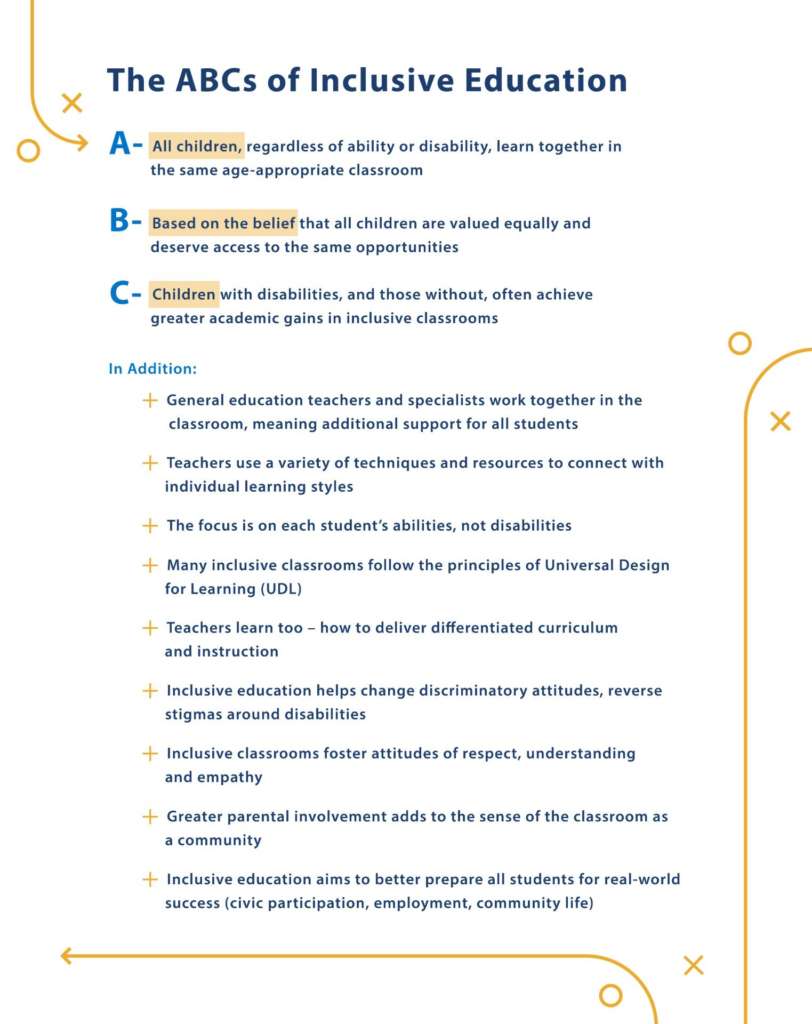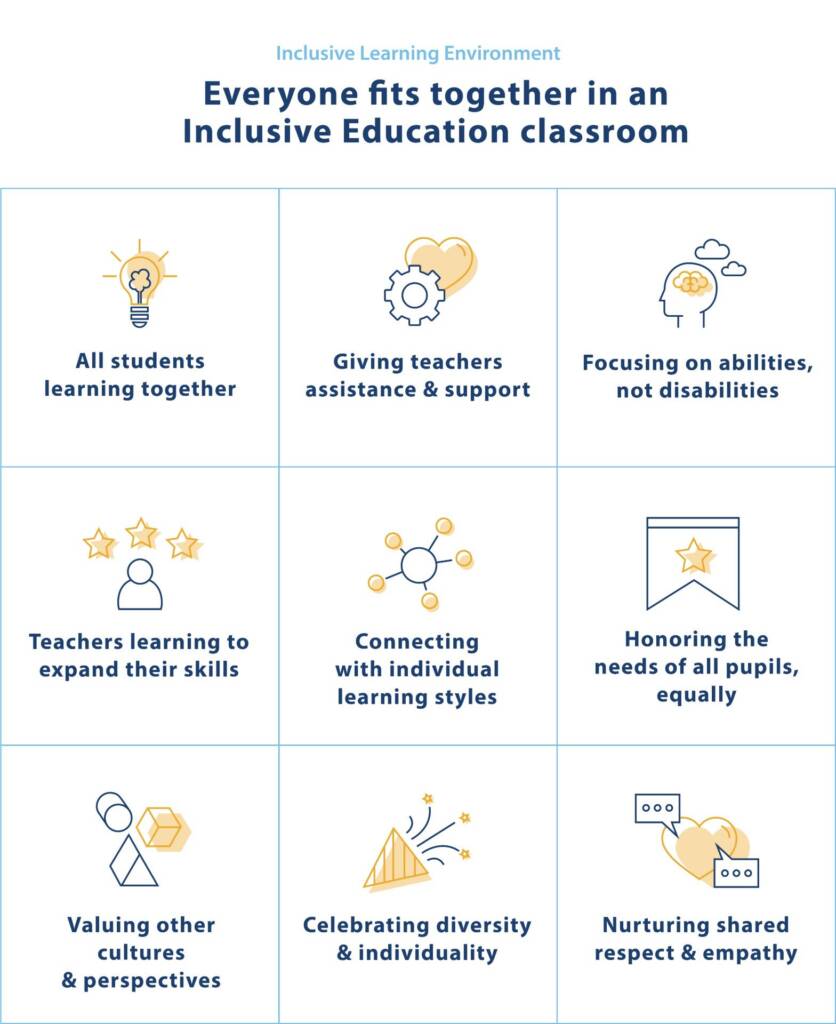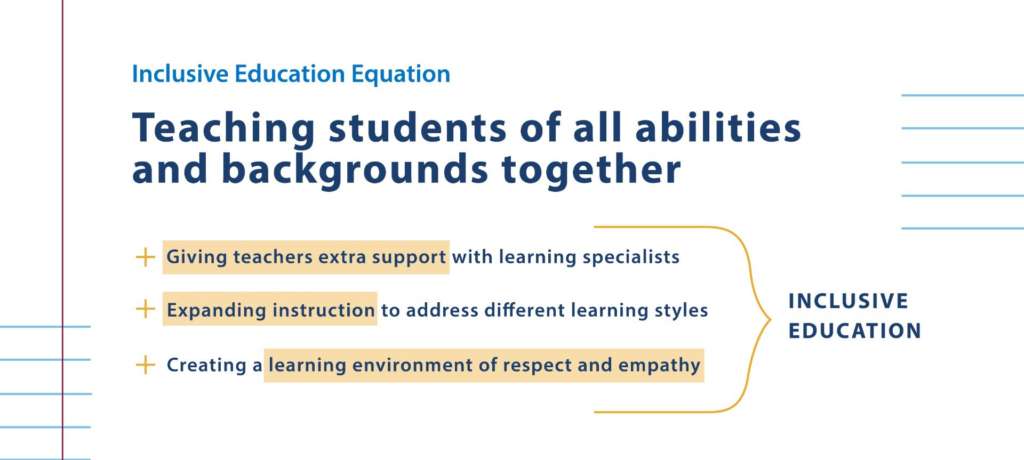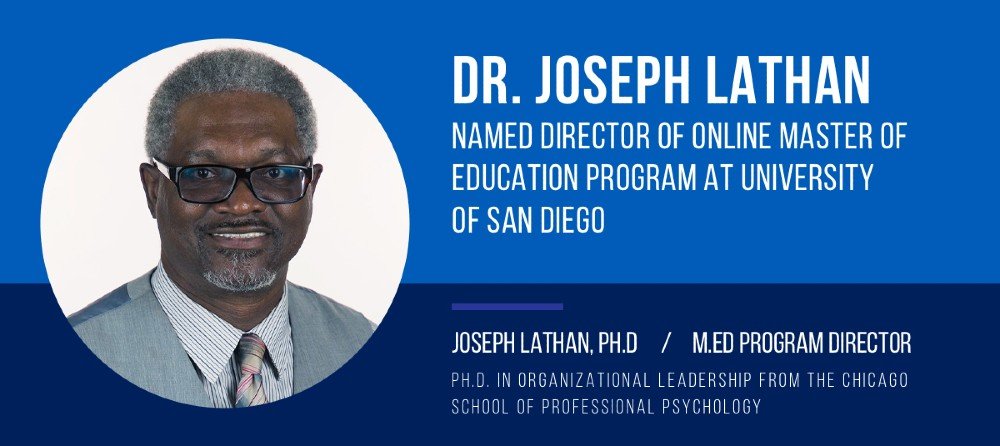General education teachers and special education teachers alike are recognizing the benefits of inclusive education. This approach to learning aims to cultivate learning environments that are equitable and nurturing to every student.
What is Inclusive Education?
Inclusive learning provides all students with access to flexible learning choices and effective paths for achieving educational goals in spaces where they experience a sense of belonging. In an inclusive education environment, all children, regardless of ability or disability, learn together in the same age-appropriate classroom. It is based on the understanding that all children and families are valued equally and deserve access to the same opportunities.

Inclusive learning goes hand in hand with Universal Design for Learning (UDL), a set of principles for curriculum development that gives all students an equal opportunity to learn. According to the National Center on Universal Design for Learning, “UDL provides a blueprint for creating instructional goals, methods, materials, and assessments that work for everyone — not a single, one-size-fits-all solution but rather flexible approaches that can be customized and adjusted for individual needs.” UDL shares many commonalities with the Theory of Multiple Intelligences espoused by Harvard Professor Howard Gardner, whose work documented “the extent to which students possess different kinds of minds and therefore learn, remember, perform and understand in different ways.”
Why is Inclusive Education Important?
Studies have shown the benefits that inclusive classrooms offer for children with disabilities and their peers. Instead of pulling children out of the classroom to offer them specialized instruction, in an inclusive classroom special education teachers come into the classroom. This allows for general education teachers and specialists to work together in the same learning environment, benefiting all students, who are offered additional resources and support. This support often results in greater academic gains for students with disabilities as well as students without disabilities.
Think Inclusive reported on a 2001 study that examined “academic progress for students with disabilities in general education and self-contained classrooms over two years; 47.1% of students with disabilities in general education made progress in math, compared to 34% in self-contained classes. Reading progress was comparable in both settings. Interestingly, the study found typical peers made higher gains in math when students with disability were present. Researchers hypothesized that extra help and support in these classes created gains for all students.”
Additional benefits include better communication skills and improved social skills for students with disabilities, as well as fewer incidents of disruptive behavior and absences.

Inclusive Education Strategies
Are you ready to introduce an inclusive education environment into your classroom? To do so means challenging the status quo, removing curriculum barriers and presenting educational goals in interesting ways to engage all learners and serve all students equitably. Below are four important strategies to consider when designing an inclusive classroom and curriculum.
- Use universal design principles to create accessible classrooms
UDL is a set of principles that were born from the desire to offer every student an equal opportunity to learn, based on the idea that every person has their own unique and individual learning style. According to UDL, three primary brain networks are responsible for how a person learns: the recognition network, the strategic network and the affective network. The three main principles of UDL — Representation (the what of learning), Action and Expression (the how of learning), Engagement (the why of learning) — were formed based on these three brain networks. Understanding the foundation of UDL — the principles and brain networks — is imperative for teachers who wish to implement UDL in the classroom. The National Center on Universal Design for Learning has a plethora of resources and information for educators interested in universal design. You’ll find videos offering helpful implementation tips and ideas in the “UDL Principles and Practices” section of their YouTube Channel. Luis Perez, author of Mobile Learning for All, suggests starting small. In an article in The Journal, he said, “You’re not going to apply every single (guideline) to every single lesson. It depends on which ones are relevant to your learning goals. Start with a single lesson or activity and then build success from that, and then start to look at other parts of your curriculum.” - Use a variety of instructional formats
The first principle of universal design theory is the “what” of learning. It says to use “multiple means of representation.” While some students are visual learners, others may grasp information better when it is presented through text or when it is spoken orally or taught through kinesthetic learning. Some students do best with a combination of the above. While these differentiated teaching methods may support the needs of students with disabilities, they also offer a diversity of instruction to the entire classroom, giving each and every student an opportunity to learn in the way they do best. Similarly, using different mediums to present information and engage students is important in inclusive classrooms. Remember that principle two of universal design theory calls for utilizing “multiple means of action and expression.” Some students may find that their best outlet and means of expression comes through writing, while others may prefer to give an oral presentation, act out a play or create a piece of art. Each student is different and should be given the opportunity to express their knowledge through the methods that work best for them. Additionally, teachers can use a diversity of materials and mediums to engage students. Examples of mediums could include theater, art, video and computer software in addition to the traditional mediums of lecture and text. Through using varied teaching techniques and mediums, teachers can increase the engagement of their entire class, not just the students who respond to a particular style of learning and expression. - Know your students’ IEPs/504s
To create an equitable learning environment for everyone, it is important to familiarize yourself with students’ IEP or 504 plans. If you have a student with a 504 or IEP plan, you are legally required to make any necessary accommodations as outlined in the 504 or IEP. You can work with the school counselor or teaching specialists to better understand the student’s specific needs. Much like the concept of inclusive learning, 504s were designed to ensure that students with disabilities are allowed to learn in a regular classroom environment, while still being provided with services, educational aids or accommodations they may require. An IEP is only slightly different than a 504; the difference being that students with an IEP may require additional educational services outside of the regular classroom. These services are typically provided and monitored by additional support staff. - Develop a behavior management plan
Disruptive classroom behavior can affect not just the teacher, but the other students in the classroom as well. Developing a behavior management plan can help you prepare for the inevitable moment a student or students exhibit disruptive behaviors — with the understanding that some behaviors are of much less consequence than others (talking out of turn vs. being defiant or aggressive). The behavior plan should be shared with parents and students so that everyone is aware of the expectations and consequences should those expectations not be met. The most effective plans typically involve a great deal of positive reinforcement and a clear understanding of the expectations. There are several different types of behavior management plans you can implement depending on the needs of your classroom, including a whole group plan, a small group plan, an individual plan or an individual plan designed for particularly challenging students.

Inclusive Learning Resources for Teachers
- Inclusive Schools Network – ISN is a digital resource for families, schools and communities looking to design and implement effective inclusive schools. They offer a wide variety of resources including assessment tools, collaboration strategies, technology advice and much more.
- National Center for Learning Disability – NCLD advocates for people with disabilities offering programs and resources for parents, young adults, professionals and educators. They also publish reports and studies on a range of topics related to disability and offer scholarship information for students with learning and attention issues.
- Wrightslaw – Wrightslaw is a great resource for those looking to learn more or stay up-to-date on special education law, education law and advocacy for children with disabilities.
- TASH – TASH works to advance inclusive communities through advocacy, research, professional development, policy and information and resources for parents, families and self-advocates. They offer several different publications including a blog, annual reports, a podcast and more.
- ASCD – The Association for Supervision and Curriculum Development (ASCD) covers a range of educational topics not limited to inclusive learning. This is a great resource for educators across all disciplines and grade levels, whether they are looking to create an inclusive school or simply find new strategies to improve their effectiveness in the classroom.
FAQ
At the University of San Diego, we believe in the power of inclusive learning. We also understand the importance of an educated teaching force when it comes to inclusion and special education. That’s why we offer a 100% online Master of Education degree with a specialization in Inclusive Learning, Special Education and Universal Design. To learn more and view the curriculum, visit the USD Master of Education program page.





